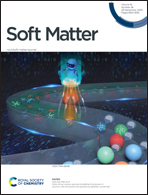Controlling the drying-induced peeling of colloidal films
Abstract
In this work, we investigated the effect of the suspension properties on the drying dynamics and the resulting film peeling instability. To do so, a comprehensive series of experiments were conducted using drops of aqueous mixtures of colloidal silica dispersions and polyethylene oxide (PEO) additives. Time-lapse digital microscope images of the evaporating droplets show that film peeling can be discouraged and eventually eliminated with an increase in PEO concentration and molecular weight. This is due to the additives modifying the suspension properties which in turn modify the drying front length across the evaporating surface. Our result extends the understanding of the physics of film failure which is relevant information for various industrial processes such as in inkjet printing and coating applications.



 Please wait while we load your content...
Please wait while we load your content...